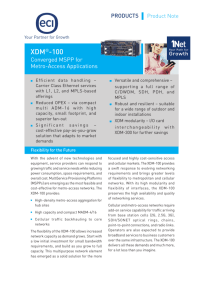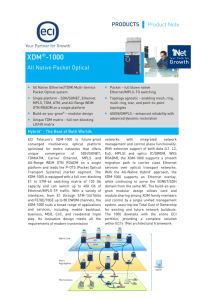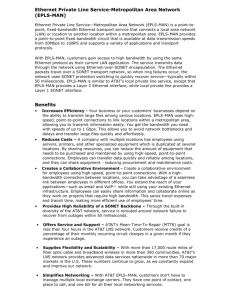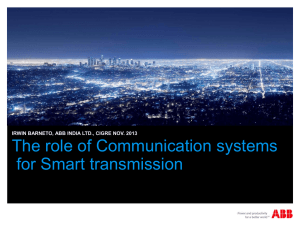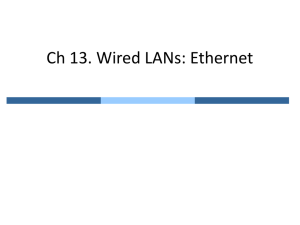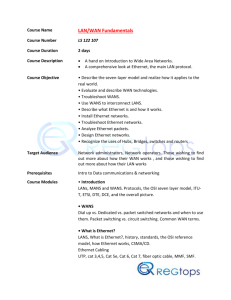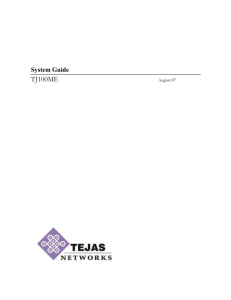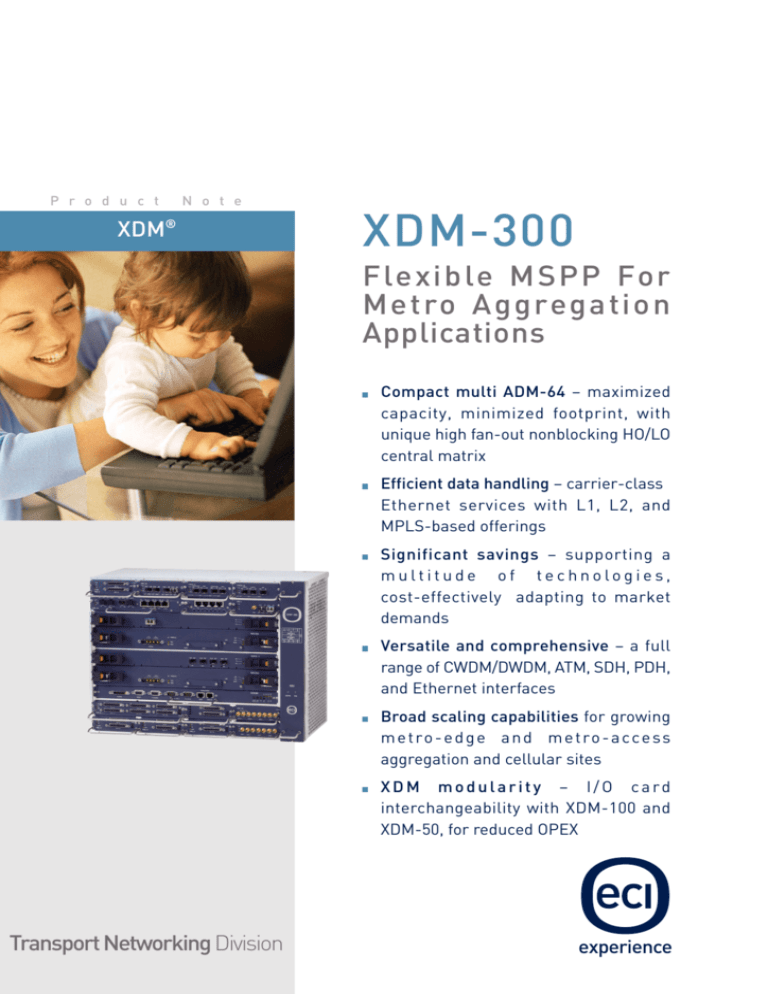
P r o d u c t
N o t e
XDM®
XDM-300
Flexible MSPP For
Metro Aggregation
Applications
Compact multi ADM-64 – maximized
capacity, minimized footprint, with
unique high fan-out nonblocking HO/LO
central matrix
Efficient data handling – carrier-class
Ethernet services with L1, L2, and
MPLS-based offerings
Significant savings – supporting a
multitude of technologies,
cost-effectively adapting to market
demands
Versatile and comprehensive – a full
range of CWDM/DWDM, ATM, SDH, PDH,
and Ethernet interfaces
Broad scaling capabilities for growing
m e t ro - e d g e a n d m e t ro - a c c e ss
aggregation and cellular sites
XDM modularity – I/O card
interchangeability with XDM-100 and
XDM-50, for reduced OPEX
Transport Networking Division
experience
BREAKING THE BARRIER
Introducing a unique architectural concept and design, the XDM-300 is the most flexible
and optimized platform for operator metro networks. The XDM-300 breaks the barrier
between metro-edge and metro-access functionality. It is a powerful platform for all
metro and access applications, featuring:
High-density metro aggregation for hub sites
High capacity and compact MADM-16/64
Metro traffic backhauling to core networks
The XDM-300 provides an extremely attractive combination of cost-effective yet high
performance carrier-class Ethernet, SDH /SONET, PDH, and CWDM/DWDM services.
This high adaptability and build-as-you-grow™ architecture leads to considerable
savings in OPEX and CAPEX.
AGGREGATION WITHOUT AGGRAVATION
The great challenge that operators are currently facing is how to handle the growing
demands for STM-1/OC-3 and STM-4/OC-12 interfaces delivered from access rings,
customer premises equipment, and BTS/NB cells. This rise is being driven by the
increasing demand by business customers for higher bandwidth to support voice, data,
and video services. In response, operators are replacing traditional customer location
equipment, mostly based on old PDH platforms, in order to manage miniature MSPPs.
This trend is becoming more and more ubiquitous and the influence on access networks
is significant.
The superior XDM-300 fan-out is the key for meeting the growing metro and access
interface aggregation demands covering a wide range of services over a variety of
technologies and infrastructures. This affords smooth and easy integration with existing,
as well as future, network applications.
SERVICES WITH A SMILE
The XDM-300 is based on a novel approach to MSPP for metro applications. It supports
scalable STM-1/4/16/64/OTU2 (OC-3/12/48/192) aggregates and flexible access topologies.
Designed and developed to provide a quick response to evolving networking requirements,
this platform brings new levels of flexibility to metropolitan/access transport, cellular,
and access ring-type architectures.
The XDM-300 provides a data service layer that terminates WAN links and aggregates
Ethernet traffic arriving from the access network. Traffic can be carried to local Gigabit
Ethernet interfaces or routed to the metro-core over SDH/SONET, enabling the following
services and features:
Carrier-class Ethernet as well as traditional SDH voice-centric services
Gradual in-service capacity expansion based on service provisioning needs
Nonblocking low-order/high-order cross-connect functionality
Sublambda grooming resulting in high utilization of existing fibers and top efficiency
in transmission of different types of services
Common function redundancy and I/O interface protection
Full compatibility with its XDM-100 and XDM-50 family counterparts (interchangeable
I/O cards)
A TOUCH OF CLASS
The XDM-300 is the preferred carrier-class transmission solution for emerging Ethernet-based
applications. Data applications have become the driving force in the telecommunications industry,
providing a new approach to data service provisioning and connectivity. These include:
Triple Play
Business Connectivity (Enterprise and Medium/Small Offices)
Mobile Aggregation
DSLAM Transport and Aggregation
The XDM-300 is equipped with a broad range of Ethernet cards to support all services with
end-to-end QoS. For example, the Layer 1, Layer 2, and MPLS cards are part of the overall
XDM data-aware architecture. The system supports seamless Ethernet service delivery from
metro-core all the way to customer premises.
This platform is the optimal method to provide data-centric services, as follows:
Ethernet Line (E-Line) for point-to-point connectivity, including:
Ethernet Private Line (EPL)
Ethernet Virtual Private Line (EVPL)
Virtual Private Wire Service (VPWS)
Ethernet LAN (E-LAN) for multipoint-to-multipoint (any-to-any) connectivity, designed for
multipoint Ethernet VPNs and native Ethernet Transparent LAN Services (TLS), such as:
Ethernet Private LAN (EPLAN)
Ethernet Virtual Private LAN (EVPLAN)
Virtual Private LAN Service (VPLS)
E-Tree (Rooted-Multipoint) for point-to-multipoint
Multicast Tree connectivity, designed for BTV/IPTV
services, such as:
Ethernet Private Tree (EP-Tree)
Ethernet Virtual Private Tree (EVP-Tree)
MPLS Routed-P2MP Multicast Tree (Drop & Continue)
BACKHAUL TO THE FUTURE
Mobile operators are confronted with tough competition resulting from Average Revenue
Per User (ARPU) erosion (largely due to reduction in voice services), technology shifts
from legacy TDM-oriented 2/2.5G to 3G and 3.5G, as well as the introduction of wireline
services (FMC/FMS). These factors are forcing operators to re-think their transport
strategy in order to reduce OPEX while supporting the migration from TDM to
packet-oriented networks. ECI's backhauling solution comprises two approaches, both
managed under a unified management and OAM system. This allows mobile operators
at different stages of infrastructure to select the most appropriate and efficient solution
for their particular needs for the future.
Low to Medium 3G Penetration
In this scenario, 2G (or TDM-oriented) services expand in parallel with the introduction
of 3G packet-based (ATM and/or IP) technology. Basing the solution on ECI's leading
XDM MSPP product line, the operator gains:
Native support of all legacy service expansion with highest QoS
Integrated support of ATM with highest utilization of backhaul resources
Variety of Ethernet services over MPLS for introducing IP UTRAN and/or data
applications for business services
Integrated NG optics (ROADM) supporting both capacity expansion AND topology
changes in the most flexible and efficient way
The main benefit of this method is that it supports any stage of evolution with the most
appropriate technology (and media), while allowing smooth migration towards full
packet-based networks when needed.
The XDM-300 was designed as an optimized platform to be located at HUB sites in the
RAN in terms of size, functionality, and price, featuring:
Scalable and flexible solutions for increasing traffic demands
Higher bitrate multiple ring and link closure toward hub sites (STM-1/4/16/64 or
OC-3/12/48/192 rings)
Aggregate traffic from BTSs and Node B's from E1s to GbE
Efficient handling of advanced data services (WLAN, IP migration) and additional
data services provided by cellular operators
Fast provisioning with superior QoS
Higher network resiliency at any layer or interface
Medium to High 3G Penetration (developed markets)
Operators who face massive increases in packet-based traffic (high penetration of
HSPA-based services or introduction of mobile WiMAX in the future) require a more
packet-oriented infrastructure. In most scenarios, the introduction of a new packet layer
is implemented gradually, in parallel with the existing MSPP network. In this case, the
interoperability and ability to create end-to-end services, as well as OAM for the services
on both networks, is crucial. ECI's solution provides a unified network approach and
smooth evolution from legacy to packet-based.
COLOR YOUR WORLD
The XDM-300's CWDM capability makes it a natural choice for metro-edge and
metro-access environments. As a powerful converged multiservice platform optimized
for metro networks, XDM-300 integrates high-capacity and cost-conscious CWDM with
SDH sublambda grooming and efficient data transport, enabling smooth migration from
today's SDH transmission technologies to CWDM terabit capacities.
The compact XDM-300 shelf houses a variety of CWDM, OADM, transponder, OFA,
combiner, and other optical cards and modules used to process, amplify, and monitor
multichannel signals. It provides up to 16 integral slots for transponder and combiner
modules for a variety of services, including:
Lambda-based services from 100 Mbps up to 2.5 Gbps
Data, digital video, Ethernet, and other digital services
High-order transmission paths for IP networks
THE 5TH DIMENSION
The remarkable LightSoft® multidimensional network management system for converged
networks handles two physical layers and several technology layers, including SDH/SONET,
optical, and Ethernet (data). Its advanced GUI includes flexible fault management tools,
end-to-end trail definition, database backup, and sophisticated Customer Network
Management (CNM) that enables monitoring and allocating available network resources
to a wide variety of clients for maximum profitability. Within one integrated management
system, LightSoft allows users to fully control and obtain a complete overview of all
network elements.
TECHNICAL SPECIFICATIONS
Interfaces, Topologies, and Protection
SDH tributary and aggregate interfaces
STM-1, STM-4, STM-16, STM-64
SONET tributary and aggregate interfaces
OC-3, OC-12, OC-48, OC-192
PDH tributary interfaces
E1, E3, DS-3
Data-aware interfaces
10/100/1000 Mbps, Ethernet, IP, ATM
Topologies
Mesh, multi-ring, ring, star, linear
System Capacities
Pluggable SFP/XFP support
Electrical, non-colored, C/DWDM
Ethernet
Layer 1:
128 x 10/100BaseT
64 x 10/100 FX
64 x 1000BaseT
64 x 1000 SX/LX
SDH/SONET
128 x STM-1/OC-3
64 x STM-4/OC-12
24 x STM-16/OC-48
6 x STM-64/OC-192
PDH
504 x E1, 48 x E3, 48 x DS-3
Layer 21:
96 x 10/100BaseT
96 x 10/100 FX
32 x 1000 BaseT
32 x 1000 SX/LX
MPLS:
64 x 10/100BaseT
64 x 10/100 FX
64 x 1000 BaseT
64 x 1000 SX/LX
CWDM Specifications
Number of channels
1, 2, 4, 8, 16
Max. distance
Over 100 km
Channel spacing (nm)
20
Continuous 2R/2R transponder
STM-1/4/16, OC-3/12/48, digital video, Ethernet,
Fiber Channel, ESCON, FICON, etc.
CWDM combiner
2 x GbE/FC/FICON to 2.7 Gbps OTN
Other Specifications
-40 VDC to -75 VDC
Max. power dissipation
1600 W, 5465 BTU/h
Operating temperature range
-5°C to +55°C
-23°F to +131°F
Operating RH range
5% to 95%
Environmental standards
ETS 300 019-1-3 Class 3.2
ETS 300 019-1-1 Class 1.2
ETS 300 019-1-2 Class 2.3
Safety
EN 60950-1:2006, according to LVD Directive 72/23/EEC
EN 60825-1&2
NEBS
GR-63-CORE (level 3), GR-1089-CORE, UL 60950:1,
last edition
EMC
EN 300 386-2, 1TR9
Management
End-to-end management of all layers and services
Physical dimensions
325 mm (H) x 443 mm (W) x 300 mm (D)
12.8 in (H) x 17.4 in (W) x 11.8 in (D)
Reaching maximum ports per shelf requires the use of DIOM cards as port extenders
ECI Headquarters
Tel: +972-3926-6555
Fax: +972-3928-7100
EMEA
Tel: +44-1256-388000
Fax: +44-1256-388144
Asia Pacific
Tel: +65-6297-7335
Fax: +65-6299-2716
Russia
Tel: +972-3926-8548
Fax: +972-3926-6452
America
Tel: +1-954-772-3070
Fax: +1-954-351-4404
Copyright © 2007 ECI Telecom. All rights reserved. Information in this document is subject to change without notice. ECI Telecom assumes no responsibility for any errors that may appear in this document.
XDM_pn_XDM-300_01_en_01-03-07
1
Power input

